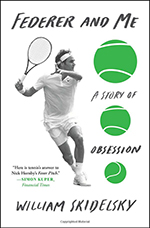My Federer Obsession:
Part 3
William Skidelsky

As I said in the first excerpt from my book, it took me a while to become obsessed with Roger Federer. In the years following my first sighting of him at Wimbledon, I paid him relatively little attention. I kept vague tabs on his results but I didn't watch many of his matches.
The problem was that I had too much else going on. I was in my mid twenties and was trying to carve out a niche for myself in the adult world--a goal that, since university, had seemed impossibly distant.
Work preoccupied me a good deal. I was finally making some headway as a journalist. There were the standard mid twenties social pursuits: going to parties, hanging out with friends.
And I was falling in love—something that hadn't happened in quite a while. My relationship with my new girlfriend--a fellow journalist--was all consuming. The result was that Roger Federer, for all his appeal, seemed like a distant, tangential figure. My life didn't have room in it for me to become obsessed with him.
By late 2006, though, things were beginning to change. I had just turned thirty and I felt less pressured at work. My relationship was running into trouble; my girlfriend and I hadn't split up, but it increasingly seemed like a possibility.
We were spending less time together (or rather, she was spending less time with me) and this meant, among other things, that I had more time on my hands. I'd also recently started playing tennis again. Through work, I'd met various writers and publishers who were enthusiastic players. The great thing about writers is that they tend to be available to play at any time, unbeholden as they are to office timetables.

This suited me. Although I had a desk job, I found that there were plenty of opportunities to bunk off and play tennis. I could nip out at lunchtime, or arrange early-morning hits. Journalists, in my experience, aren't generally expected to be at their desks before ten a.m.)
Although rusty to begin with--I'd barely picked up a racket in fifteen years--I soon located the remnants of my game and some of my former fluency returned. To my surprise, I not only discovered that I loved playing, but that I was a match for the cream of London's tennis-playing literati.
Playing a sport, of course, isn't a prerequisite for becoming a fan. But it does help. As a consequence of taking up tennis again, I became more susceptible to the allure of Federer. I started paying closer attention to his results and I couldn't help but notice how phenomenally successful he was being.
Whole years seemed to go by in which he would barely lose a match. In the summer of 2006, at a family gathering of my girlfriend's, I remember meeting an aspiring tennis pro, a young British player on the fringes of the tour. I asked him whom, of today's top players, he particularly admired.
He told me he'd recently been on some practice courts near Federer and he couldn't believe how good he was. As he spoke, awe entered his voice and his eyes acquired a faraway look. Increasingly, I realized, this was how Federer was being viewed. He was becoming a figure of legend, almost a god.
David Foster Wallace
Not long after this, I happened to stumble across an essay on Federer by David Foster Wallace. It was first published in the New York Times, but I read a reprint in the Guardian. I was already a fan of Wallace's writing--his fiction in particular--and the piece, unsurprisingly, made a big impression on me.

Here was a palpably clever writer--something of a genius himself--talking in candidly reverential terms about the wonder, the beauty, of Federer's tennis. I was struck not only by Wallace's concept of the "Federer moment"--the instances when his play appears to defy the laws of physics--but also by the way he sought to locate his subject within the game's overall trajectory.
His argument had a density, a subtlety, to it that I had rarely encountered in sports writing. And his sense of the sport's development very much chimed with my own. Wallace's basic contention was that men's tennis had, for the previous few decades, been moving in a linear direction.
Thanks to a combination of composite rackets, related changes in technique, and advances in athleticism, a single style had come to dominate the sport. This style-the "power baseline" game--was, as its name suggested, based on hitting the ball with tremendous power (and copious topspin) from the back of the court. According to Wallace, it was Lendl who had pioneered the style in the eighties, in the nineties players like Agassi and Courier had raised it to new heights, and, more recently, Rafa Nadal had taken it "just as far as it goes."
The problem with the power baseline style, Wallace suggested, wasn't that it was inherently boring--it was actually an improvement on the "two-second points of old-time serve and volley or the moonball tedium of classic baseline attrition"--but it was "somewhat static and limited" and, if it were to prove the "evolutionary end-point of tennis," that would be a problem for the game.
Federer, however, had shown another way forward. He had introduced--or rather, reintroduced--elements such as subtlety and variety, an "ability to read and manipulate opponents, to mix spins and speeds, to misdirect and surprise, to use tactical foresight and peripheral vision."
Yet the point about Federer-and here was Wallace's kicker-was that he could do all those things while also being a "first-rate, kick ass power baseliner." He had demonstrated a new way of playing tennis that was as attractive as it was effective, and had done so from within the modern game.

"With Federer, it's not either/or," Wallace wrote. "The Swiss has every bit of Lendl or Agassi's pace on his groundstrokes, and leaves the ground when he swings, and can out-hit even Nadal from the backcourt...It's just that that's not all he has...He is Mozart and Metallica and the combination is somehow wonderful."
Wallace ended his essay on a note of optimism. At that year's Wimbledon, which he'd attended, the junior event had been a "variegated ballet," with players deploying "drop volleys and mixed spins, off-speed serves, gambits planned three shots ahead--all as well as the standard-issue grunts and booming balls." The clear implication was that Federer's approach was starting to influence tennis more widely, expanding the sport's very possibilities. "For the first time in years," Wallace wrote, "the game's future is unpredictable."
Every line of Wallace's analysis intrigued me and his words were still in my head a month or so later when, in Shanghai, I chanced upon Federer on TV. My brother was living in the city for a semester, teaching the history of Western political theory at one of its universities.
In November, I went to stay, with him for a week. For the first few days of my visit, my brother had teaching duties, and so while he went out to school Shanghai's youth in the benefits of democracy, I mooched around his apartment. The Tennis Masters Cup-the end-of-year tournament featuring the world's top eight players, which at that point was held in Shanghai was on. There were posters advertising it all over the city. Switching on the telly one afternoon, I happened upon Federer, again playing Roddick. Through the haze of my jetlag, I watched, transfixed. Roddick was playing well and for most of the first two sets appeared the more likely winner.

But then, just when things were beginning to look desperate for Federer, he upped his game. Shots that had been winning Roddick the point not only started coming back, but started coming back as winners. Angles that had previously seemed closed to Federer suddenly became available.
This went on for half an hour or so, a period during which Federer appeared incapable of missing-responded, indeed, to each successive difficulty by coming up with an even more spectacular shot.
The momentum swung decisively and Federer comfortably won the third set. I watched with a rising sense of astonishment. I already knew--or thought I knew--how good Federer was, but this was brilliance beyond anything I'd imagined. I remember leaping up off the sofa, dancing with joy, my exclamations mingling with the utterances of the Chinese commentators.
Perhaps it was the result of my discombobulated condition--the jet lag, the unfamiliar surroundings--but Federer's tennis that afternoon struck me as unearthly, stupendous, possessed of a magnificence I'd never before seen on a tennis court. I hadn't known such excellence was possible.
And the effect upon me was instantaneous. By the time the match was over, something in me had begun to shift. My future--or a part of it--had been determined. I knew that I wanted to follow this man, take what opportunities I could to luxuriate in the silky wondrousness of his play. My obsession had begun.





